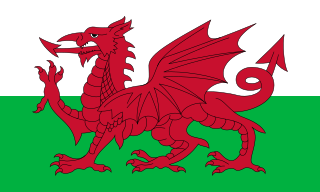Related Research Articles

Llywelyn ap Gruffudd, sometimes written as Llywelyn ap Gruffydd, also known as Llywelyn the Last, was the last native Prince of Wales from 1258 until his death at Cilmeri in 1282. Llywelyn was the son of Gruffydd ap Llywelyn Fawr and grandson of Llywelyn the Great, he was one of the last native and independent princes of Wales before its conquest by Edward I of England.

Hedd Wyn was a Welsh-language poet who was killed on the first day of the Battle of Passchendaele during World War I. He was posthumously awarded the bard's chair at the 1917 National Eisteddfod. Evans, who had been awarded several chairs for his poetry, was inspired to take the bardic name Hedd Wyn from the way sunlight penetrated the mist in the Meirionnydd valleys.

In Welsh culture, an eisteddfod is a festival with several ranked competitions, including in poetry and music. The term eisteddfod, which is formed from the Welsh morphemes: eistedd, meaning 'sit', and fod, meaning 'be', means, according to Hywel Teifi Edwards, "sitting-together." Edwards further defines the earliest form of the eisteddfod as a competitive meeting between bards and minstrels, in which the winner was chosen by a noble or royal patron.
In Welsh-language poetry, cynghanedd is the basic concept of sound-arrangement within one line, using stress, alliteration and rhyme. The various forms of cynghanedd show up in the definitions of all formal Welsh verse forms, such as the awdl and cerdd dafod. Though of ancient origin, cynghanedd and variations of it are still used today by many Welsh-language poets. A number of poets have experimented with using cynghanedd in English-language verse, for instance Gerard Manley Hopkins. Some of Dylan Thomas's work is also influenced by cynghanedd.
Welsh poetry refers to poetry of the Welsh people or nation. This includes poetry written in Welsh, poetry written in English by Welsh or Wales based poets, poetry written in Wales in other languages or poetry by Welsh poets around the world.
Medieval Welsh literature is the literature written in the Welsh language during the Middle Ages. This includes material starting from the 5th century AD, when Welsh was in the process of becoming distinct from Common Brittonic, and continuing to the works of the 16th century.
Lewys Glyn Cothi, also known as Llywelyn y Glyn, was a prominent 15th century Welsh poet who composed numerous poems in the Welsh language. He is one of the most important representatives of the Beirdd yr Uchelwyr or Cywyddwyr ("cywydd-men"), the itinerant professional poets of the period between the 1284 Statute of Rhuddlan and c. 1600.
Y Mab Darogan is a messianic figure of Welsh legend, destined to force the Germanic Anglo-Saxons and Vikings out of Britain and reclaim it for its Celtic Briton inhabitants. A number of figures have been called Y Mab Darogan in history ). An extensive corpus of medieval Welsh prophetic verse, beginning with Armes Prydain, is centred on the figure of Y Mab Darogan.

The Chairing of the Bard is one of the most important events in the Welsh eisteddfod tradition. The most famous chairing ceremony takes place at the National Eisteddfod of Wales, and is always on the Friday afternoon of Eisteddfod week. Winners are referred to as Y Prifardd. The custom of chairing the bard is, however, much older than the modern eisteddfod ceremony, and is known to have taken place as early as 1176.
Tudur Aled was a late medieval Welsh poet, born in Llansannan, Denbighshire. He is regarded as a master of cynghanedd.
Llywarch ap Llywelyn was an important medieval Welsh poet. He is also known by his bardic name, "Prydydd y Moch".
Gruffudd ab yr Ynad Coch was a Welsh court poet.

Daniel Evans, better known by his pseudonym, Daniel Ddu o Geredigion, was a Welsh language poet.
Culture and Society in Gwynedd during the High Middle Ages refers to a period in the History of Wales spanning the 11th, 12th, and 13th centuries. The High Middle Ages were preceded by the Early Middle Ages and followed by the Late Middle Ages. Gwynedd is located in the north of Wales.
Dic Jones, was a Welsh-language poet and Archdruid of the National Eisteddfod of Wales.
Gerallt Lloyd Owen was a Welsh-language poet. He is considered to be one of Wales's leading "strict-metre" poets.
Cerdd dafod is the Welsh tradition of creating verse or poetry to a strict metre in the Welsh language.

Ymadawiad Arthur is a Welsh-language poem, some 350 lines in length, by Thomas Gwynn Jones. It won its author the Chair at the National Eisteddfod in 1902 but was several times heavily revised by him in later years. It portrays King Arthur's last hours with his companion Bedwyr at the battle of Camlann and his final departure for Afallon. Ymadawiad Arthur is a hugely influential work, widely held to have opened a new era for Welsh-language poetry, marking the beginning of the early 20th century renaissance of Welsh literature.
Gruffudd ap Maredudd ap Dafydd was a Welsh bard working in Anglesey in the service of the Tudors of Penmynydd. One of the last of the older school of poets known as the Gogynfeirdd, he resisted the innovations in Welsh verse-form which took place in his lifetime. About 2400 lines of his work have survived in the Red Book of Hergest. His best-known poem is "Gwenhwyfar", an elegy to a young lady. He was described by the literary historian D. Myrddin Lloyd as "the finest of all the late Gogynfeirdd poets" and by Saunders Lewis as "one of the greats".
References
- ↑ "Yr Arwr - Wicidestun". cy.wikisource.org.